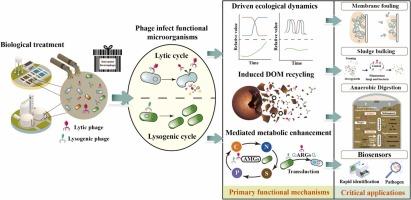被低估的噬菌体在生物废水处理系统中的作用:最新进展和挑战
IF 11.3
1区 环境科学与生态学
Q1 ENGINEERING, ENVIRONMENTAL
引用次数: 0
摘要
噬菌体(噬菌体)是生物废水生态系统的重要组成部分,其浓度远远超过这些细菌。尽管它们很重要,但它们经常被忽视,被认为是生物处理过程中的“暗物质”。噬菌体在污水处理厂(WWTPs)中塑造宿主微生物群落的动态进化中起着关键作用,通过与宿主微生物的相互作用推动其功能进化。噬菌体是驱动微生物生态动态和调节代谢功能的关键。在宏观尺度上,通过病毒分流释放的有机物表现出增强的生物利用度,并促进了基于病毒穿梭体介导的生物泵的有机元素循环。此外,在微观尺度上,噬菌体介导的基因转移可以帮助功能微生物提高代谢效率,适应环境胁迫。然而,这一过程也带来了环境风险,特别是通过水平基因转移和质粒传播抗生素抗性基因。与传统的化学和物理方法相比,噬菌体具有明显的优势,包括优越的效率和环境可持续性。然而,基于噬菌体的生物防治策略的发展受到噬菌体特异性和生物处理系统复杂性的限制。人工智能和遗传技术的最新进展为优化噬菌体的应用提供了有希望的途径。深入研究噬菌体生态学,为提高操作稳定性、处理效率和针对性生物防治策略奠定理论基础。本文章由计算机程序翻译,如有差异,请以英文原文为准。

Underestimated Roles of Phages in Biological Wastewater Treatment Systems: Recent Advances and Challenges
Bacteriophages (phages) are vital components in biological wastewater ecosystems, whose concentrations are far exceeding those bacteria. Despite their importance, they are often overlooked and regarded as the "dark matter" in biological treatment processes. Phages play a pivotal role in shaping the dynamic evolution of host microbial communities within wastewater treatment plants (WWTPs), driving their functional evolution through interactions with host microorganisms. Phages are crucial in driving microbial ecological dynamics and regulating metabolic functions. At the macroscopic scale, the organic matters released through viral shunting demonstrate enhanced bioavailability and facilitated organic element cycling based on viral shuttle-mediated bio-pump. Additionally, at the micro-scale, gene transfer mediated by phages can assist functional microorganisms in enhancing metabolic efficiency and adapting to environmental stress. However, this process also introduces environmental risks, particularly the dissemination of antibiotic resistance genes through horizontal gene transfer and plasmids. Phages offer distinct advantages over conventional chemical and physical methods, including superior efficiency and environmental sustainability. Nonetheless, the development of phage-based biocontrol strategies is constrained by phage specificity and the complexity of biological treatment systems. Recent advances in artificial intelligence and genetic technologies provide promising avenues for optimizing phage applications. Further research into phage ecology is essential to lay a theoretical foundation for enhancing operational stability, treatment efficiency, and targeted biocontrol strategies.
求助全文
通过发布文献求助,成功后即可免费获取论文全文。
去求助
来源期刊

Journal of Hazardous Materials
工程技术-工程:环境
CiteScore
25.40
自引率
5.90%
发文量
3059
审稿时长
58 days
期刊介绍:
The Journal of Hazardous Materials serves as a global platform for promoting cutting-edge research in the field of Environmental Science and Engineering. Our publication features a wide range of articles, including full-length research papers, review articles, and perspectives, with the aim of enhancing our understanding of the dangers and risks associated with various materials concerning public health and the environment. It is important to note that the term "environmental contaminants" refers specifically to substances that pose hazardous effects through contamination, while excluding those that do not have such impacts on the environment or human health. Moreover, we emphasize the distinction between wastes and hazardous materials in order to provide further clarity on the scope of the journal. We have a keen interest in exploring specific compounds and microbial agents that have adverse effects on the environment.
 求助内容:
求助内容: 应助结果提醒方式:
应助结果提醒方式:


